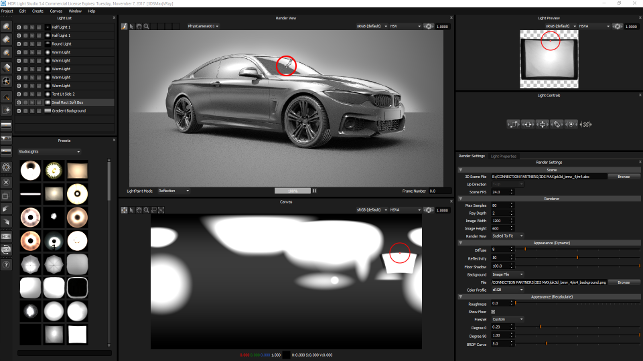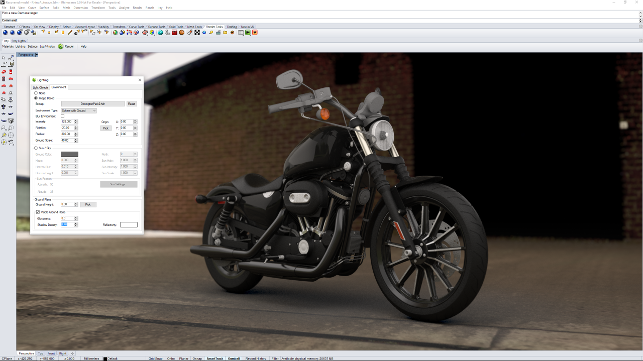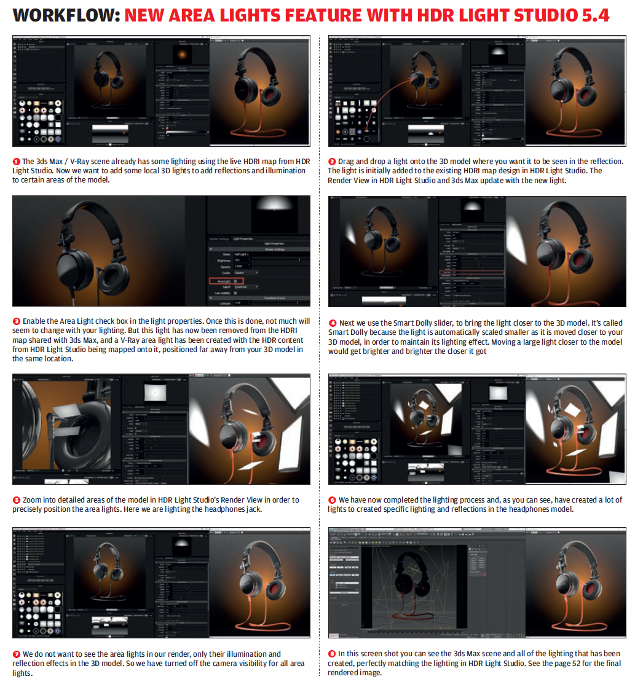HDR Light Studio 5.4 – The march of the physically-based renderer seems unstoppable, but what if you want to gain a little more control over those all important HDR light environments? Al Dean looks at a system that gives you exactly that and much more
With the wider adoption of physically-based rendering and its reliance on high-dynamic range (HDR) imagery as the source of lighting, comes a challenge.
While, traditionally, visual artists might have spent hours, if not days, setting up lighting scenes manually, today we can simply load a HDR image and leave the system to handle much of the heavy lifting.

While it’s perfect for those generating a quick image, rendering out something that’s for a quick design review or that has simple lighting requirements, for those looking to go the extra mile, HDR imagebased lighting lacks fine control over the appearance of your rendering work.
To help with this, HDR Light Studio was developed by Lightmap to take HDR image environments to that next level.
The company’s background is in running a visualisation studio, so it identified this need in 2009 and the system has been on sale for a good while now.
Its maturity has really started to bear fruit in the last few releases. So let’s dig into HDR Light Studio and see what the team has in store for the latest 5.4 release.
HDR Light Studio is a cross platform system that runs on Windows, Mac OSX and Linux. Once you’ve got it licensed (there’s also a 15 day trial available) and up and running, you’ll need to pay attention to any system integrations.
The system has some smart connections to a number of different rendering systems, ranging from Autodesk’s 3ds Max, Maya and VRED, through to Cinema 4D, Modo, DeltaGen and Maxwell. If you’re also using Dassault SolidWorks Visualize, then you’ll find a nice connection there too.
Most are automatically installed, but if you have a non-standard installation path, you might need to do a little manual adjustment of settings and preferences.

The basics
There are two essential workflows for HDR Light Studio. The first is building a lighting environment from scratch and the second is adapting an existing environment to better suit your purposes.
In both these workflows, the use of the system remains the same. Essentially, you load your environment and start to adjust it, adding in light sources where needed to provide the lighting and refl ections required on your model.
This is done by choosing the type of light you want to add in, then positioning it. For this you can either position it in the HDR preview (the lower window in figure 1) or by placing a highlight on your 3D model (and having the system work out its position in your HDR image).
For some time now, the system has allowed you to load in your own models (rather than using the default teapot), this means you can place highlights more accurately and gain more context for your edits.
Of course, if you’re running with the system connected to a separate renderer, then you’ll also be able to transfer any edits and see where you’re at.
Interestingly for this release, Lightmap is also introducing more control over how lights are positioned. With spherical environment maps, you’re pretty much stuck with being able to position light entities on the surface of the sphere.
What Lightmap has now done is introduce the ability to adjust the lights using 3D like X, Y and Z control (as you can see in figure 2).
When you output the final environment, these are then mapped into that final image. These tools are not just useful for creating light but for adding and positioning additional lights or other content to HDR images as well.
Studio standards
While it’s perfectly possible to create your own lights from scratch, choosing from a wide range of different templates and starter entities, the system is supplied with a huge range of highly accurate representations of real world lights.
These have been expanded again for this release and you’ll find a vast variety of lights there to pick and choose from, from standard spots, light umbrellas, softboxes and all manner of real world photography equipment.
Improved 3D lighting tools
Sometimes when lighting a product shot, you need light/reflections to affect only a certain part of the 3D model. But image based lighting using a high-dynamic-range imaging (HDRI) map will affect the whole of the 3D scene because, effectively, this lighting surrounds the whole scene.
For this reason, HDR Light Studio has been extended to allow lights to be promoted away from the distant HDRI map surrounding your scene, and into 3D space as area lights, mapped with HDR lighting content that is interactively controlled by HDR Light Studio.
These lights can then be moved around the model, still using the patented LightPaint system, to click on the 3D model to position the light, but with the addition of a distance slider, to bring the light closer or further away from the model.
This has been done seamlessly, as lights in HDR Light Studio are promoted off the HDRI map and into 3D with the click of a single check box.
This feature is currently supported when using HDR Light Studio with Maya, 3ds Max, Cinema 4D and MODO plug-in connections What makes this a massive time saver, and really fun to use, is that once a light is converted into an area light within HDR Light Studio, the connection plug-in will build the light for your chosen renderer and then links the HDR image content to it. These area lights are then totally controlled via HDR Light Studio.

In conclusion
Rendering has been a core part of many companies’ workflow for years now and the number of folks doing it on a regular basis is much larger than has ever been the case.
Much of this is down to greater availability of good quality rendering tools that make the process much easier.
HDR images gives these types of tools access to very quick lighting set-ups, but there’s a lack of control. HDR Light Studio gives you that control back – it allows you to either build custom maps for your specific projects or to adapt those you have access to already to suit.
The ability to position highlights (and lowlights) exactly where you want them provides a few benefits.
Firstly, you don’t need to manually create the lights in your system of choice – saving you both time and effort for what’s always a frustrating process.
Secondly, if you have photography experience, you’ll be able to make full use of it with this tool – without the need to do a great deal of work. The team’s work to include presets and templates that are not only familiar, but accurate, makes this possible.
Thirdly, the environment map you create can be reused easily, both within the same project (those working on render sets for product families will know that pain), but also available for other projects down the line.
Lastly, it provides capabilities that can be reused in whatever rendering systems you have access to. Whether doing animation work in 3ds max and static imagery work in KeyShot or a more CAD integrated tool, HDR Light Studio works with them all (what varies is the intelligence of the connection between them).
The team has also done some work on the pricing for the system. If you want an annual subscription (including maintenance), you can get on board for £295 a year. If you prefer to buy a permanent licence, it’ll cost you £695, including a year’s support.
If you think about what you’re getting here, that’s a bargain in anyone’s book. This is essentially a photography lighting studio on your workstation. Compared to the cost of either renting a studio for a day to do photo shoots or buying that equipment yourself, it’s a steal.
The fact that it connects to most of the leading systems makes it even more attractive. Get hold of the 15 day trial and give it a whirl and see how you can push your render work to the next level.
Create your own HDR environment

High Dynamic Range image environments have become the de facto standard for getting your rendered scene lighting correct, click here for our guide on how to create your own.
| Product | HDRLightStudio |
|---|---|
| Company name | Lightmap |
| Price | £295 pa Subscription or £695 permanent licence |







